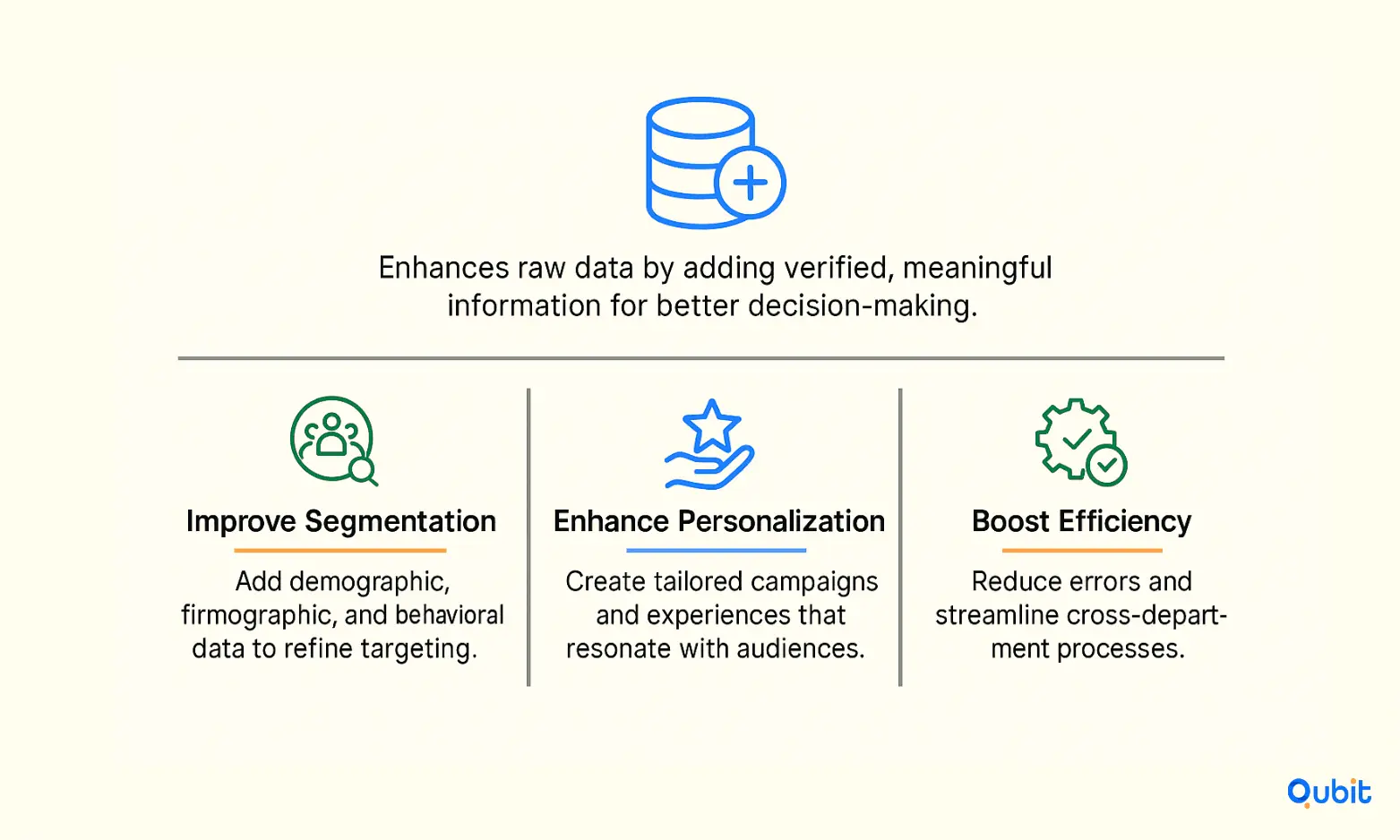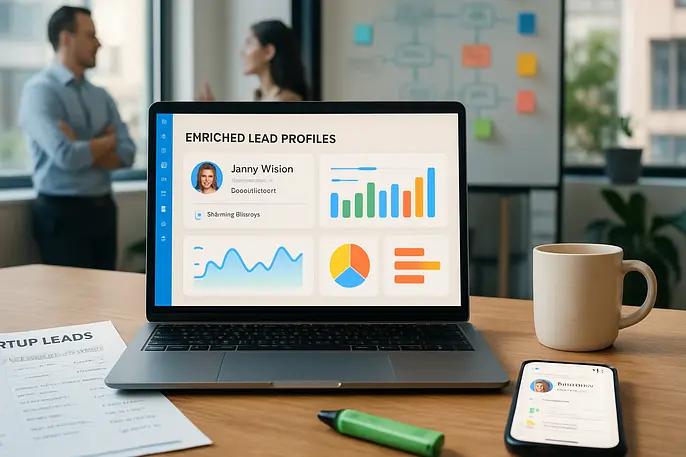Qualifying leads is a critical step for startups aiming to secure investor interest and drive growth. However, raw data alone often lacks the depth needed to make informed decisions. This is where data enrichment services come into play, transforming basic information into actionable insights. By refining and expanding data, startups can better understand their prospects and tailor outreach strategies effectively.
A closer study of artificial intelligence in prospecting is provided in ai investor prospecting, illustrating how AI-driven platforms align with your broader outreach efforts. This article will explore how data enrichment transforms raw data into actionable intelligence for investor lead qualification. From fundamentals to real-world applications, let’s jump right in.
Data Enrichment Fundamentals
Data enrichment is a transformative process that enhances raw data by adding verified and meaningful information. This practice ensures that businesses have access to reliable, actionable insights, which are crucial for informed decision-making. Unlike data cleansing, which focuses on removing inaccuracies or inconsistencies, data enrichment builds upon existing datasets to improve their quality and relevance.

Why Data Enrichment Matters
For B2B operations, enriched data can unlock numerous benefits. It enables businesses to:
- Improve customer segmentation: By adding demographic, firmographic, or behavioral data, companies can better understand their target audience.
- Enhance personalization: Enriched data allows for tailored marketing campaigns and customer experiences.
- Boost operational efficiency: Reliable data reduces errors and streamlines processes across departments.
Pre-Enrichment Data Assessment: Setting the Stage for Success
Before diving into enrichment, startups must first assess the state of their existing data. Enriching inaccurate or outdated information is like building on a cracked foundation, it compromises the entire outreach strategy.
Data Health Audit
Start by reviewing completeness, accuracy, and consistency. Identify missing fields such as industry, funding stage, or decision-maker titles, and flag outdated entries for removal or verification.
Prioritization Matrix
Not all leads deserve equal enrichment effort. Use a simple scoring system to determine which leads have the highest potential impact — for example, investors who have recently backed similar startups, or prospects active in your target geography.
Compliance Checkpoint
Before enrichment begins, confirm that all collected data adheres to data protection laws such as GDPR or CCPA. This ensures your enrichment strategy starts from a legally sound position.
The Step-by-Step Process of Data Enrichment
Data enrichment involves a systematic approach to ensure accuracy and usability:
1. Data Collection
The process begins with gathering raw information from both internal and external sources.
- Internal sources may include CRM records, transactional logs, website analytics, customer feedback, and email sign-up data.
- External sources may involve public databases, third-party data providers, industry reports, or social media platforms.
The goal at this stage is comprehensiveness, capturing enough relevant data points to provide a strong foundation for enrichment.
2. Verification
Once collected, the data is subjected to a validation process to filter out inaccuracies, inconsistencies, and outdated entries.
- This involves cross-referencing information against trusted databases or verification tools (e.g., postal address checkers, company registries, email verification APIs).
- Inaccuracies at this stage can have downstream effects, so precision and source reliability are essential.
Verification not only ensures correctness but also builds trustworthiness in the dataset.
3. Integration
With verified and corrected data, the next step is to integrate it into existing company databases or systems.
- A key challenge here is data consistency — avoiding conflicting formats, duplicate records, or mismatched fields.
- Many organizations use data integration platforms or ETL (Extract, Transform, Load) processes to ensure a seamless merge.
The outcome is a centralized, unified view of the enriched data, accessible across teams for consistent decision-making.
4. Analysis
Once enriched and integrated, data becomes significantly more valuable when analyzed for patterns, correlations, and actionable insights.
- Businesses often use advanced analytics tools, AI algorithms, or BI dashboards to identify trends such as customer behavior shifts, market opportunities, or operational inefficiencies.
- Statistical modeling, segmentation, and predictive analytics can help turn raw numbers into strategic foresight.
5. Application
The final step is embedding enriched data into real-world business strategies and operations.
For operational teams, enriched data can inform supply chain optimizations, product development, and service improvements.
At this stage, enriched data shifts from being a static asset to a dynamic driver of growth and competitive advantage.
In marketing, it may mean hyper-personalized email campaigns, targeted ads, and improved lead scoring.
In sales, it can enhance prospect qualification, shorten sales cycles, and improve conversion rates.
Common Challenges in Data Enrichment
Despite its advantages, data enrichment comes with challenges that businesses must address:
- Integration Issues: Combining enriched data with legacy systems can be complex and time-consuming.
- Scalability: As data volumes grow, maintaining enrichment processes at scale requires robust infrastructure.
- Regulatory Compliance: Adhering to data privacy laws, such as GDPR, is essential to avoid legal repercussions.
By proactively managing these challenges, businesses can maximize the value of their enriched data while ensuring compliance and scalability.
Data Enrichment Best Practices & Techniques
Optimizing data enrichment requires a structured approach and the adoption of innovative techniques. To achieve meaningful results, businesses must prioritize clarity in their enrichment goals and employ strategies that ensure data accuracy and relevance.
1. Define Clear Objectives
The foundation of any successful data enrichment initiative lies in setting precise and measurable objectives. Without a clear understanding of what you aim to achieve, efforts can become scattered and ineffective. For instance, are you enriching data to improve customer segmentation, enhance lead scoring, or refine investor targeting? Identifying these goals upfront ensures that every step of the process aligns with your desired outcomes.
2. Multi-Source Validation
Relying on a single data source can lead to inaccuracies and inconsistencies. Multi-source validation, where data is cross-referenced across multiple reliable sources, significantly improves data quality. This approach minimizes errors and ensures that the information remains up-to-date and actionable.
3. Embrace Automation and Real-Time Scoring
Automation has revolutionized data enrichment by enabling real-time updates and reducing manual intervention. Tools powered by artificial intelligence (AI) can autonomously adapt and refine data processes. For example, AI-Powered Autonomous Data Enrichment systems are designed to self-learn, updating records in real-time for faster and more accurate investor targeting. This innovative approach not only saves time but also ensures that your data remains relevant in dynamic environments.
4. Utilize Advanced Tools
Longer lead forms and real-time lead scoring tools can further enhance data accuracy. By collecting more detailed information upfront and scoring leads as they interact with your platform, businesses can create a more comprehensive and actionable dataset.
Adopting these best practices ensures that your data enrichment efforts yield high-quality, actionable insights.
Data Enrichment Software & Tools
Finding the right data enrichment tool can significantly enhance your B2B lead qualification process. These tools are designed to capture validated contact information, firmographic details, and technographic trends, ensuring your outreach strategies are both precise and effective. However, selecting the ideal solution depends on your specific needs, whether you require a comprehensive enterprise platform or a specialized app for niche functions.
Key Features to Consider
When evaluating data enrichment tools, automation, integration capabilities, and compliance features are critical factors to prioritize. Automation streamlines the process of updating and validating data, saving time and reducing manual errors. Integration capabilities ensure the tool works seamlessly with your existing CRM or marketing platforms, while compliance features help you adhere to data privacy regulations like GDPR or CCPA.
Popular Tools for Data Enrichment

ZoomInfo
ZoomInfo is a robust platform offering extensive contact and company data. It provides firmographic and technographic insights, making it a go-to choice for sales and marketing teams aiming to refine their lead qualification processes.Clearbit
Clearbit specializes in real-time data enrichment, pulling information from over 250 sources. Its integration capabilities with tools like Salesforce and HubSpot make it a favorite for teams looking to enhance their CRM data.Lusha
Lusha focuses on delivering accurate B2B contact data. Its browser extension allows users to quickly gather verified contact details, making it a practical choice for sales professionals.InsideView
InsideView combines data enrichment with market intelligence, offering insights into company hierarchies, financials, and industry trends. This tool is particularly useful for enterprises targeting specific market segments.
Broader Context on Outreach
Your exploration of startup lead qualification is enriched by the discussion in how to do startup outreach for investors, which lays out a broad perspective on outreach strategies and channels. This resource provides valuable insights into aligning your enriched data with effective outreach methods.
By carefully assessing your requirements and focusing on tools that align with your goals, you can ensure your data enrichment efforts translate into actionable insights for your B2B strategies.
Native CRM Data Enrichment
Integrating data enrichment directly into CRM systems like HubSpot, Zoho, or Salesforce transforms the way businesses manage their customer information. By embedding enrichment tools within the CRM itself, organizations can maintain a continuous flow of accurate, real-time data without the need for external connectors or manual updates.
This seamless integration ensures that workflows remain uninterrupted, allowing teams to focus on strategic tasks rather than troubleshooting data inconsistencies. Real-time synchronization of enriched data reduces errors and enhances the accuracy of customer profiles, which is critical for informed decision-making. For example, enriched CRM data can automatically update contact details, company information, or behavioral insights, ensuring that sales and marketing teams always work with the most current data.
Moreover, native enrichment fosters a unified data ecosystem. It eliminates the fragmentation often caused by relying on third-party tools, creating a streamlined experience for users across departments. This approach not only saves time but also improves collaboration, as everyone accesses the same reliable data.
By integrating enrichment capabilities directly into your CRM, businesses can achieve a higher level of operational efficiency and data reliability, paving the way for more personalized customer interactions and better overall performance.
Data Enrichment Use Cases & Examples
Successful data enrichment strategies have transformed how businesses approach lead qualification and investor targeting. Real-world examples provide a clear lens into the tangible benefits of enriched data, from improved targeting to reduced bounce rates.
One standout example is the Cognism Case Study, which highlights the power of verified data. By incorporating verified phone numbers into their outreach process, Cognism achieved a 25% quarter-over-quarter increase in connect rates. This improvement significantly reduced bounce rates, demonstrating how accurate and enriched data can directly impact engagement and overall campaign success.
These results underscore the importance of precision in data enrichment. When businesses refine their data, they not only improve the quality of their leads but also enhance the efficiency of their outreach efforts. This approach ensures that every interaction is more targeted, leading to better engagement and higher conversion rates.
Conclusion
Qualifying startup leads effectively begins with mastering the fundamentals of data enrichment. By implementing best practices, exploring advanced techniques, and utilizing practical tools, businesses can create a robust framework for lead qualification. A clear, narrative-driven approach ensures that enriched data not only informs decisions but also builds a compelling story that resonates with potential investors.
Adopting these strategies can lead to measurable improvements in identifying and connecting with the right opportunities. The process becomes more than just a numbers game—it transforms into a strategic effort that drives meaningful results.
If you're looking to optimize your data enrichment efforts to qualify startup leads effectively, we at Qubit Capital offer Investor Discovery and Mapping services designed to connect you with the right investors. Let’s get started.
Key takeaways
- Data enrichment transforms raw data into actionable intelligence by adding verified insights.
- It is distinct from data cleansing and involves a systematic process of assessment and validation.
- Best practices include setting clear objectives, utilizing automation, and ensuring multi-source validation.
- Tools like ZoomInfo and Apollo provide robust support for B2B data enrichment.
- Real-world examples, such as the Cognism Case Study, highlight tangible improvements in investor lead qualification.
Frequently asked Questions
What is data enrichment for investor leads?
Data enrichment for investor leads involves enhancing raw data with verified, actionable details such as firmographic and technographic information to better qualify and target potential investors.






